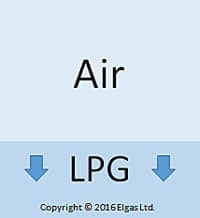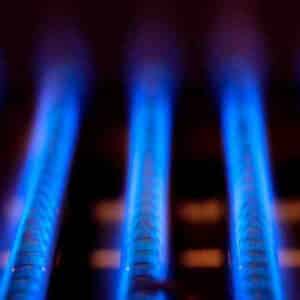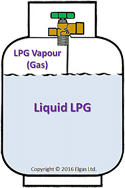Liquefied Petroleum Gas LPG in Gas – LPG Fuel (LP Gas Fuel)
What is Liquefied Petroleum Gas Properties?
Liquefied petroleum gas LPG – LP gas (liquid petroleum gas) describes flammable hydrocarbon gases including propane, butane and mixtures of these gases.
What is liquefied petroleum gas properties?
Liquefied petroleum gas (LP Gas) properties include the chemical properties of LPG – LP gas and the physical properties of LPG fuel (LP gas fuel) (liquid petroleum gas).
Included in the liquefied petroleum gas (LP Gas) properties are propane boiling point, LPG gas density, LPG fuel (LP gas fuel) energy content, flame temperature, propane chemical formula, expansion and more.
What is Liquefied Petroleum Gas: What is a LPG – Define LP Gas
What is liquefied petroleum gas LPG fuel (LP gas fuel) ? Define LP gas:
Liquefied petroleum gas LPG (liquid petroleum gas) is primarily propane, butane, isobutane, and mixtures of these LP gas fuel types.
Liquefied petroleum gas – LPG fuel (LP gas fuel) is produced during natural gas processing, where it is LPG in gas, and petroleum refining.
What is a LPG meaning? Liquefied petroleum gas LPG meaning describes flammable hydrocarbon gases.
Liquefied petroleum gas LPG (liquid petroleum gas) is liquefied through pressurisation as LPG in gas bottles and comes from natural gas processing and oil refining.
The typical constituents of LPG fuel (LP gas fuel) are propane and butane. The propane formula is C3H8 and the butane formula is C4H10.
When you define LP gas in different countries, the supply of LP gas fuel can be propane, butane or propane-butane blends.
In Australia, liquefied petroleum gas – LP gas is just propane.
Liquefied petroleum gas LPG fuel (LP gas fuel) exists as liquid or gas (vapour) as LPG in gas bottles, depending on pressure and temperature.
Natural Gas Liquids – NGL – have the same liquefied petroleum gas LPG – LP gas (liquid petroleum gas) composition plus a few more gases not normally included in LP gas.
The full NGL list includes ethane, ethene, butylenes, propylene, propene, isobutene, butadiene, pentane, pentene and pentanes plus, as well as propane, butane and isobutane.
Is Liquid Petroleum Gas the Same as Propane: Is Liquified Petroleum Gas Propane? Is Propane Liquified Petroleum Gas?
Is liquid petroleum gas the same as propane? Is liquified petroleum gas propane? Is propane liquified petroleum gas?
To define LP gas, sometimes liquefied petroleum gas LPG fuel (LP gas fuel) is propane but it can also be butane, isobutane and other NGLs.
Is propane liquified petroleum gas?
Yes, propane is liquified petroleum gas (LP Gas), as are butane and isobutane.
Remember, propane is LPG but LPG is not always propane.
What are LPG Properties: Liquefied Petroleum Gas – LP Gas
As an answer to what are LPG (LP Gas) properties, they include:
 Propane boiling point (boiling point for propane)
Propane boiling point (boiling point for propane)- Liquefied petroleum gas density – LPG gas density
- Liquified petroleum gas (liquid petroleum gas) – LPG fuel (LP gas fuel) composition – components – constituents
- Propane formula – propane chemical formula
- LPG – Propane boiling point
- Liquefied petroleum gas – LPG fuel (LP gas fuel) flame temperature
- autoignition temperature of liquefied petroleum gas – LP gas (liquid petroleum gas)
- Liquefied petroleum gas LPG – LP gas flash point
- Liquefied petroleum gas LPG – LP gas pressure
- Liquefied petroleum gas LPG (liquid petroleum gas) – LP gas odour
- Appearance of liquefied petroleum gas LPG fuel (LP gas fuel)
- Energy content of liquefied petroleum gas LPG fuel (LP gas fuel) (liquid petroleum gas)
- Liquefied petroleum gas LPG – LP gas gaseous expansion
- Combustion formula of liquefied petroleum gas LPG fuel (LP gas fuel)
- Liquefied petroleum gas LPG – LP gas limits of flammability
- Liquid petroleum gas nomenclature
- Liquefied petroleum gas LPG – LP gas (liquid petroleum gas) molecular weight
- Propane formula is C3H8 and the butane formula is C4H10
We’ll review these most commonly referenced liquefied petroleum gas (liquid petroleum gas) properties…
Liquefied Petroleum Gas (liquid petroleum gas) Properties Chart
| Propane formula |
C3H8
|
| Butane formula |
C4H10
|
|
Propane Boiling Point (boiling point for propane)
|
-42 °C or -44 °F
|
|
LPG Melting – Freezing Point
|
-188 °C or -306.4 °F
|
|
Specific Gravity of Liquid LPG
|
0.495 (25°C)
|
|
Liquefied Petroleum Gas Density
|
1.898 kg/m3 (15°C) or 0.1162 lb/ft3
|
|
Energy Content of Liquefied Petroleum Gas
|
25 MJ/L or 91,547 BTU/Gal (60°F)
|
|
Liquefied Petroleum Gas Gaseous Expansion
|
1 L (liquid) = 0.27 M3 (gas)
|
|
Propane Flame Temperature
|
1967 ºC or 3573 ºF
|
|
Limits of Flammability
|
2.15% to 9.6% LPG/air
|
|
Autoignition Temperature
|
470 °C or 878 °F
|
|
Molecular Weight
|
44.097 kg/kmole
|
What is a LPG Boiling Point – Propane Boiling Point (Boiling Point for Propane)
What is a LPG (LP Gas) boiling point or propane boiling point (boiling point for propane)?
Water boils at 100°C or 212°F, becoming a gas (steam).
In contrast, of liquefied petroleum gas – LPG (liquid petroleum gas) propane boiling point (boiling point for propane) is -42°C or -44°F, becoming gas vapour.
Liquefied petroleum gas – LPG fuel (LP gas fuel) (liquid petroleum gas) stays liquid because it is under pressure in a gas cylinder.
As a liquid, LP gas looks a lot like water.
Liquefied petroleum gas – LPG fuel (LP gas fuel) is colourless and odourless in its natural state.
Liquefied Petroleum Gas Density – What is a LPG Density & Specific Gravity
What is a LPG density?
Liquefied petroleum gas – LPG (liquid petroleum gas) gas density is 1.55 times heavier than air at 1.898 kg/m3 vs 1.225 kg/m3 for air (both 15°C at sea level).
Liquefied petroleum gas density for LP gas liquid is about half that of water at 495 kg/m3 (25°C) vs 1,000 kg/m3 (4°C) for water.
Specific gravity of propane and water is 0.495 (25°C) and 1.000 (4°C), respectively.
What is Liquefied Petroleum Gas Density – What is a LPG Specific Gravity for Liquid LP Gas – Propane
 Conversely, 1L of liquefied petroleum gas – LP gas (liquid petroleum gas) weighs 0.51kg.
Conversely, 1L of liquefied petroleum gas – LP gas (liquid petroleum gas) weighs 0.51kg.Liquefied Petroleum Gas – What is LPG Gas Density as a Gas: LPG – Propane is Heavier than Air
 1 ft3 of liquified petroleum gas – LP gas weighs 0.1162 pounds.
1 ft3 of liquified petroleum gas – LP gas weighs 0.1162 pounds.12 Important Liquefied Petroleum Gas – LPG Gas Facts
1. LPG (LP Gas) is the acronym for liquefied petroleum gas – LP gas or Liquid Petroleum Gas.
2. Liquefied petroleum gas – LPG fuel (LP gas fuel) is a group of flammable hydrocarbon gases liquefied through pressurisation and stored as LPG in gas bottles.
They are, in most cases, used as LPG fuel (LP gas fuel).
3. Liquefied petroleum gas – LP gas (liquid petroleum gas) comes from natural gas processing, where it is LPG in gas, and petroleum refining.
4. There are a number of gases that fall under the “LPG” (LP Gas) label.
These include propane, butane and isobutane (i-butane), as well as mixtures of these gases.
5. LPG gases are compressible into liquid at low pressures and stored as LPG in gas bottles.
6. The common uses for liquified petroleum gas – LP gas (liquid petroleum gas) include use for LPG in gas heating, cooking, hot water and vehicles.
LP gas is also utilised refrigerants, aerosol propellants and petrochemical feedstock.
7. Liquefied petroleum gas – LPG fuel (LP gas fuel) is stored, as a liquid, in steel vessels ranging from small BBQ gas bottles to larger gas cylinders and LPG in gas storage tanks. (45kg gas bottles shown)
What is a LPG Name? LP Gas = Propane
In Australia, liquefied petroleum gas – LP gas (liquid petroleum gas) is propane.
What is a LPG name other than LPG?
It is also called LPG Gas, LP Gas, LP Gas Fuel, Propane, BBQ Gas, Camping Gas or Autogas.
Liquefied petroleum gas – LP gas can be other gases in other countries.
Propane is a three carbon molecule with the formula C3H8.
The illustration shows a model of the molecule.
What is Liquefied Petroleum Gas – What is a LPG Temperature: Flame, Boiling Point, Melting/Freezing Point
Liquefied petroleum gas – LP gas temperature includes LPG fuel (LP gas fuel) flame temperature, propane boiling point and LP gas (liquid petroleum gas) freezing temperature.
Liquefied petroleum gas – LPG temperature also affects the pressure of LPG in gas bottles.
 Liquefied petroleum gas – LPG fuel (LP gas fuel) flame temperature (when burned with air) is 1967ºC or 3573ºF.
Liquefied petroleum gas – LPG fuel (LP gas fuel) flame temperature (when burned with air) is 1967ºC or 3573ºF.
Liquefied petroleum gas – LPG (propane) gas boiling temperature is -42°C or -44°F, as compare to water at 100°C or 212°F
The liquefied petroleum gas LPG – LP gas boiling point is where liquid propane boils and becomes vapour (gas).
LP gas (propane) gas melting/freezing temperature is at -188°C or -306.4°F.
So, liquefied petroleum gas LPG – LP gas (liquid petroleum gas) temperature for freezing is a much lower temperature than water, which freezes at 0ºC.
Liquified Petroleum Gas LPG (liquid petroleum gas) – What is a LPG Pressure?
As mentioned before, liquefied petroleum gas LPG – LP gas (liquid petroleum gas) is stored as LPG in gas bottles under pressure.
The term “LPG pressure” refers to the average force per unit of area that the gas exerts on the inside walls by the LPG in gas bottles.
(Liquefied Petroleum Gas Pressure – LP Gas Temperature Chart shown)

Liquefied petroleum gas LPG – LP gas pressure measurement is in kilopascals (kPa) or pounds per square inch (psi).
“Bar” is yet another unit of measure for pressure.
1 Bar = 100 kPa, so it is metric based but not an SI unit of measure.
Liquefied petroleum gas LPG – LP gas pressure can vary based on temperature, as shown in the chart.
The level of LP gas fill in the gas bottle comes into play when the LP gas (liquid petroleum gas) is in use, as it affects the rate of vapourisation.
Liquefied petroleum gas LPG fuel (LP gas fuel) is a liquefied gas.
So, the LP gas pressure inside the cylinder will remain the same from full until the vaporistion of the last of the liquid LP gas.
Then the LP gas pressure will fall, with the use of the last of the liquefied petroleum gas LPG – LP gas vapour.
Odourant Added for Safety
 In its natural state, liquefied petroleum gas LPG fuel (LP gas fuel) is an odourless gas.
In its natural state, liquefied petroleum gas LPG fuel (LP gas fuel) is an odourless gas.What is a LPG Hazard of Direct Contact – Cold Burns
What is a LPG Energy Content: LP Gas – Propane
What is a LPG Calorific Value of ‘Water Gas’
Liquefied Petroleum Gas (liquid petroleum gas): What is a LPG Gaseous Expansion
 Liquefied petroleum gas LPG – LP gas (liquid petroleum gas) expands to 270 times the volume when LP gas goes from liquid to gas.
Liquefied petroleum gas LPG – LP gas (liquid petroleum gas) expands to 270 times the volume when LP gas goes from liquid to gas.What is a LPG Combustion Formula Equation
 Propane Formula Equation for Complete Combustion of LPG fuel (LP gas fuel):
Propane Formula Equation for Complete Combustion of LPG fuel (LP gas fuel):What’s the Equation for Incomplete Combustion of Propane?
Propane formula for incomplete combustion in symbols: 2 C3H8 + 9 O2 → 4 CO2 + 2 CO + 8 H2O + heat
Liquefied Petroleum Gas: What is a LPG Temperature? LP Gas – Propane Flame Temperature
What are LPG Limits of Flammability
What is Liquefied Petroleum Gas (liquid petroleum gas) – What is a LPG Flash Point Temperature
What is a LPG Autoignition Temperature – Propane & Butane
LP Gas Dissipation
What is a LPG Molecular Weight for Propane – Butane – Isobutane
Liquefied Petroleum Gas – LPG Vapour (Gas) Use vs. Liquid Use
 Liquefied petroleum gas – LPG supply is either liquid or vapour.
Liquefied petroleum gas – LPG supply is either liquid or vapour.What are LPG Things You Didn’t Know – 6 Facts
While you may know some of these LP gas (liquid petroleum gas) facts, chances are you don’t know all of them.
Have a read and learn more about:
1. Real LP gas Explosions are Really Rare
2. Simulated Natural Gas from LP gas (liquid petroleum gas)
3. The Source of LP gas (liquid petroleum gas)
4. LP gas is Australian Made Energy
5. LP Gas is a Renewable Energy Source
6. LP Gas is NOT Coal Seam Gas (CSG)
1. Liquefied Petroleum Gas LPG – LP Gas Cylinder Explosions are Extremely Rare + Video
 Hollywood and the media would have you believe that liquefied petroleum gas – LP gas cylinder explosions are a common event.
Hollywood and the media would have you believe that liquefied petroleum gas – LP gas cylinder explosions are a common event.
In fact, LP gas explosions are quite rare and it is quite difficult to even make an LP gas cylinder explode on purpose.
You’ll enjoy watching the Myth Busters Video where they try to make a LP gas cylinder explode.
Most gas explosions are the result of gas leaking into a confined space, like a kitchen.
This is no more likely with liquefied petroleum gas LPG – LP gas fuel (liquid petroleum gas) than with piped natural gas.
Often, the gas bottle itself is not even involved in the event, as LP gas bottles are always stored outdoors.
2. Simulated Natural Gas from Liquefied Petroleum Gas – LPG
Most people have never even heard of Simulated Natural Gas (SNG) let alone know that it can be made with liquefied petroleum gas – LPG (liquid petroleum gas).
Mixing vapourised LP gas with air produces SNG.
We can SNG use in place of natural gas, as it has near identical combustion characteristics.
It can be used alone or mixed with regular natural gas.
There are no changes required in burners, regulators or gas jets.
There are a number of reasons to use SNG:
• To help meet peak demand when natural gas supplies are inadequate
• To operate while in preparation for the start-up of a natural gas supply
• As a stand-by in the event of a natural gas supply disruption
Simulated natural gas has a few names.
Besides SNG, it is also called propane-air and LP gas-air.
3. What is a LPG Source: Liquefied Petroleum Gas – LP Gas
Many people mistakenly think of liquefied petroleum gas LPG – LP gas (liquid petroleum gas) as a by-product.
In reality, LP gas is a valuable co-product produced from gas fields and crude oil refining.
They process the gas stream from natural gas fields to separate the gases present.
These include methane, ethane, propane, butanes and pentanes.
Impurities are also removed, including water.
The produced gases are each funneled into their own supply streams.
They capture propane and butane, the two common types of liquified petroleum gas – LP gas, and store them in their liquefied form.
The same is true of crude oil refining.
The refinery process creates many co-products.
The co-products include gasoline, diesel fuel, asphalt base, heating oil, naphtha, kerosene and LP gas.
4. What is a LPG Autogas? LP Gas is Australian Made Energy
Liquefied petroleum gas LPG – LP gas (liquid petroleum gas) is the only motor fuel in which Australia is self-reliant.
Unlike both petrol and diesel, for which Australia relies on imports, we produce more LP gas than we consume.
Not only is Australia completely self-sufficient in liquefied petroleum gas – LP gas but it is also a net exporter of LP gas.
In 2013, Australia produced 2.3 Million tonnes of LP gas (liquid petroleum gas) .
That satisfied the local demand of 1.5 million tonnes, with net exports of 815,000 tonnes.
5. What is a LPG Renewable Energy Source – Liquefied Petroleum Gas
Liquefied petroleum gas – LPG (liquid petroleum gas) has gone from being a traditional fossil fuel to a new form of renewable energy.
Scientists have created a genetically engineered version of the common E. coli bacteria.
This version produces propane (LP gas fuel).
So, Liquefied petroleum gas – LPG (LP Gas) is now a renewable energy.
The bacteria consume sugar.
With genetic modification, and the help of a couple of enzymes, they make propane.
The propane produced is chemically identical to regular propane.
6. Liquefied Petroleum Gas – LP Gas is NOT Coal Seam Gas (CSG)
There is some confusion over what Coal Seam Gas (CSG) is and what it is not.
While CSG may contain various gases, typical CSG is 95% to 97% pure Methane.
Liquefied petroleum gas LPG – LP gas fuel (liquid petroleum gas) is not Methane.
Liquefied petroleum gas LPG – LP gas (liquid petroleum gas) is Propane.
New Residential LPG customer?
New Business LPG customer?
Existing ELGAS customer?
- BBQ – Gas and Charcoal BBQ Features – Charcoal BBQ vs Gas BBQ Comparison - March 31, 2025
- GPL Gas (GPL Fuel) – GLP Gas – LPG Gasul: GLP-GPL Gas Station - March 26, 2025
- Think LPG When Building a New Home - February 26, 2025
Steve Reynolds
Technical Consultant
Steve Reynolds is a leading expert in the LPG industry with over 22 years of experience. As part of the national management team at ELGAS, Steve ensures the safe and efficient storage, handling, and transportation of LPG. He serves as the lead investigator for incidents and collaborates with authorities on industry developments.
Steve is a technical advisor to Standards Australia and Gas Energy Australia (GEA), and an active member of the World LPG Association (WLPGA), contributing to global standards and technical reviews. He holds a BSc. (Hons) in Industrial Chemistry from UNSW and has held senior safety and technical roles at ELGAS, making him a trusted authority in LPG safety and standards.



